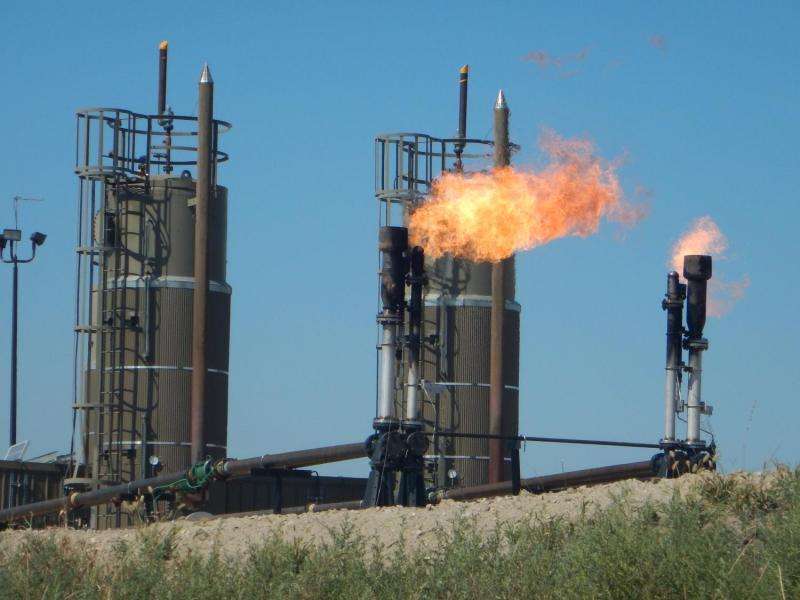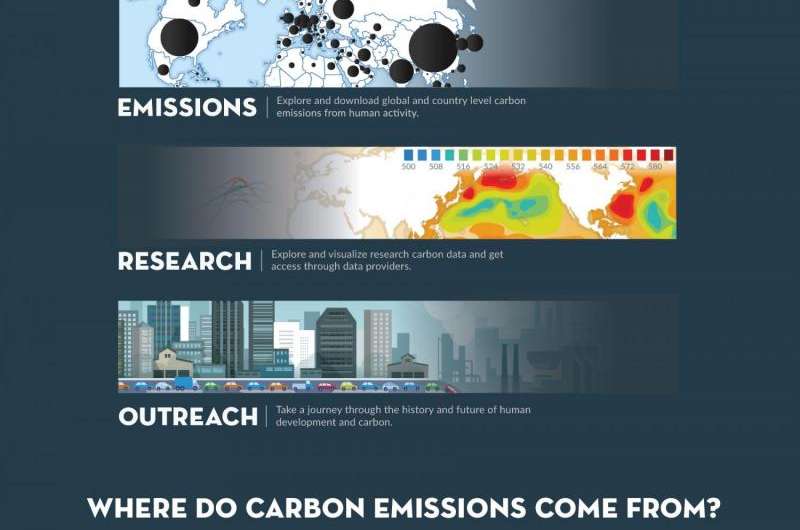Global fossil-fuel emissions could decline in 2015, study finds

Annual global carbon dioxide emissions from fossil fuels could drop slightly in 2015, according to a report from the Global Carbon Project led by a Stanford University researcher. This surprising result contrasts with the rapid growth in emissions before 2014, underlining the need for action to stabilize and permanently lower global CO2 emissions, the researchers conclude.
"In 2014, global CO2 emissions from burning fossil fuels grew by just 0.6 percent," said lead author Rob Jackson, a professor of Earth system science at Stanford. "This year we expect total emissions to flatten or drop slightly, despite strong growth in gross domestic product worldwide."
While CO2 emissions have slowed during times of economic recession, this would be the first decline during a period of strong global economic growth, Jackson said.
The new report, titled "Reaching Peak Emissions," was published on Dec. 7 in the journal Nature Climate Change, with detailed data published simultaneously in Earth System Science Data.
"Decreased coal use in China was largely responsible for the decline in global CO2 emissions," said report co-author Corinne Le Quéré of the University of East Anglia in the United Kingdom. "After a decade of rapid growth, China's emissions rate slowed to 1.2 percent in 2014 and is expected to drop by 3.9 percent in 2015."
The researchers identified China as the world's top CO2 emitter in 2014, responsible for 27 percent of global emissions, followed by the United States (15.5 percent), the European Union (9.5 percent) and India (7.2 percent).
"Whether a slower growth in emissions will be sustained depends on the use of coal in China and elsewhere, and where new sources of energy will come from," said co-author Pep Canadell of Australia's Commonwealth Scientific and Industrial Research Organization (CSIRO). "In 2014, more than half of new energy needs in China were met from non-fossil fuel sources, such as hydro, nuclear, wind and solar power."
This trend was also accompanied by slower global growth in petroleum use and faster growth in renewables, with wind and solar capacities achieving record increases in 2014.
"The most promising finding in our report is the coupling of lower carbon emissions with a strong economic growth of more than 3 percent," said Jackson, a senior fellow at the Stanford Woods Institute for the Environment and at the Precourt Institute for Energy. "But even if we reach peak global emissions within a decade or two, we'll still be emitting massive amounts of CO2 from burning fossil fuels."
Achieving climate stabilization will require reducing emissions to near zero, he added.
"Reaching zero emissions will require long-term commitments from countries attending the climate meeting in Paris this week and beyond," Jackson said.

Other co-authors of the report are Robbie Andrew, Jan Ivar Korsbakken and Glen Peters, Center for International Climate and Environmental Research (Norway); and Nebojsa Nakicenovic, International Institute for Applied Systems Analysis (Austria).
The Global Carbon Project, part of the International Council for Science and Future Earth, addresses climate change by providing regular analyses of the global carbon cycle.
More information: Robert B. Jackson et al. Reaching peak emissions, Nature Climate Change (2015). DOI: 10.1038/nclimate2892
'Global Carbon Budget 2015' is published in Earth System Science Data.
Data and figures: www.globalcarbonproject.org/carbonbudget
HEADLINE STATS BY COUNTRY
CHINA
China was the biggest emitter of CO2 in 2014, releasing 9.7 billion tonnes (27 per cent of the world total).
Emissions from china will strongly influence the global emissions over the next decade.
After rising 6.7 per cent per year for the previous decade, China's emissions growth slowed to 1.2 per cent in 2014 and is expected to decrease in 2015.
China's decreased coal use largely accounts for the break in global emissions growth in 2014 and 2015.
China, the world's largest wind-energy producer, installed 23 GW of new wind capacity last year alone.
China's emissions per capita are 7.1 tonnes - compared to 17.4 tonnes per capita in the US, 6.8 tonnes per capita in the EU, and 2.0 tonnes per capita in India.
US
The US was the second biggest emitter of CO2 in 2014, releasing 5.6 billion tonnes (15 per cent of the world total).
Emissions in the US have declined by 1.4 per cent annually over the last decade. This decline is projected to continue through 2015.
The US produces 17.4 tonnes of CO2 per capita each year.
EU
The EU was the third biggest emitter of CO2 in 2014, releasing 3.4 billion tonnes (10 per cent of the world total).
The EU is the region with the strongest decline in emissions - averaging 2.4 per cent per year in the past decade.
The decline in emissions in the EU of 210 MtCO2 in 2014 was the same size as the increase in emissions in India of 205 MtCO2.
Although outsourcing of emissions to emerging economies played a substantive role in early reductions, emissions transfers via trade from the EU to China and elsewhere have declined since 2007.
The EU produces 6.8 tonnes of CO2 per capita each year.
INDIA
India was the fourth biggest emitter of CO2 in 2014, releasing 2.6 billion tonnes (7.2 per cent of the world total).
India's emissions today match those of China in 1990.
The increase in emissions in India of 205 MtCO2 was the same size as the decline in emissions in the EU of 210 MtCO2 in 2014.
Per capita emissions continue to be well below the global average at 2.0 tonnes of CO2 each year.
India's challenge is the need to provide 1.3 billion people with greater access to energy.
If present trends persist, India's emissions will match those of the EU in 2-3 years.
For global CO2 emissions to peak and decline quickly, part of India's new energy needs must come from low-carbon technologies.
UK
The UK released 0.43 billion tonnes of CO2 in 2014 (1.2 per cent of the world total).
UK emissions decreased by 9 per cent in 2014 and are now 28 per cent below 1990 levels. Emissions from the consumption of goods and services produced elsewhere has started to decrease, after rising during the period 1990-2007.
Journal information: Nature Climate Change
Provided by Stanford University




















